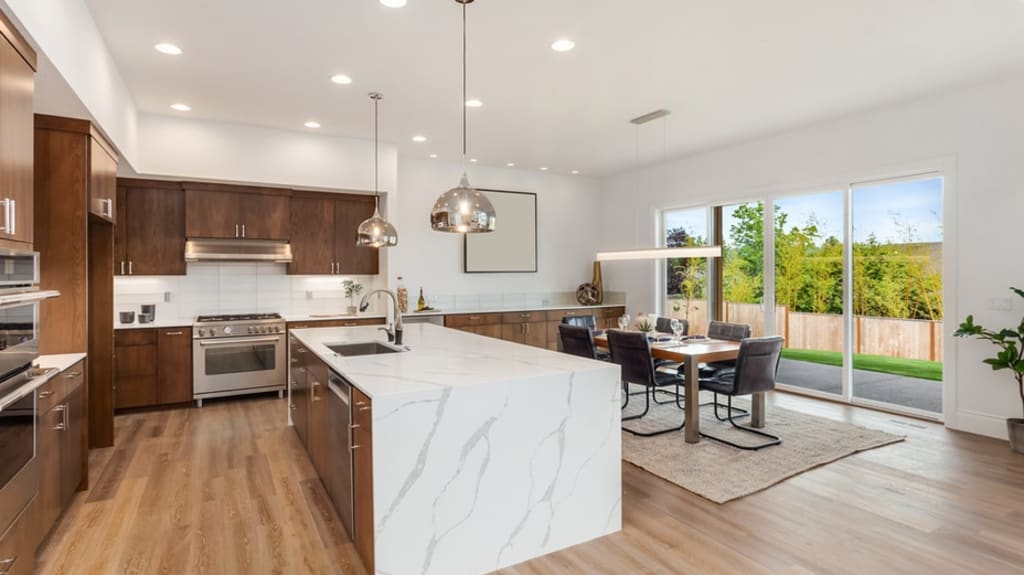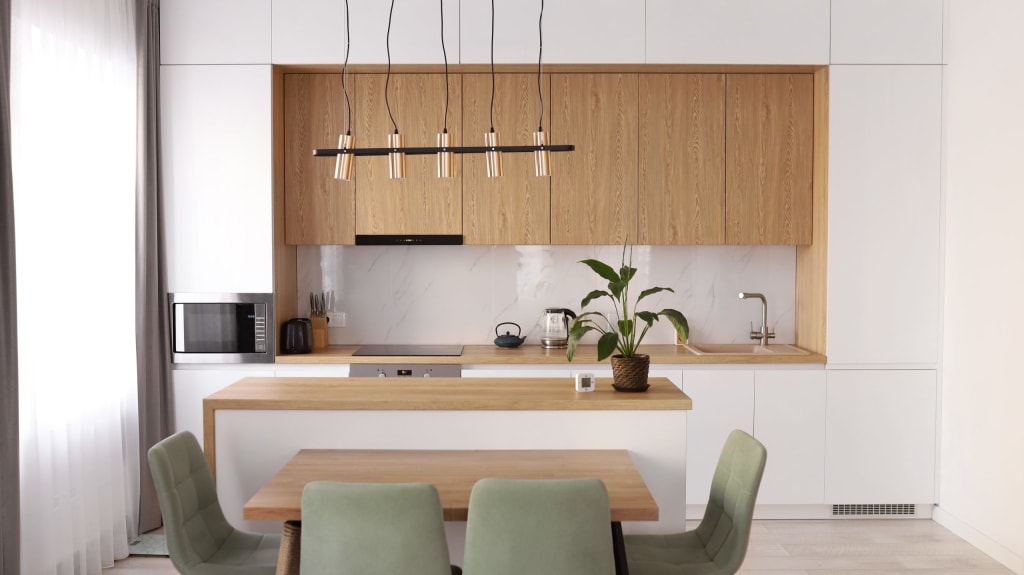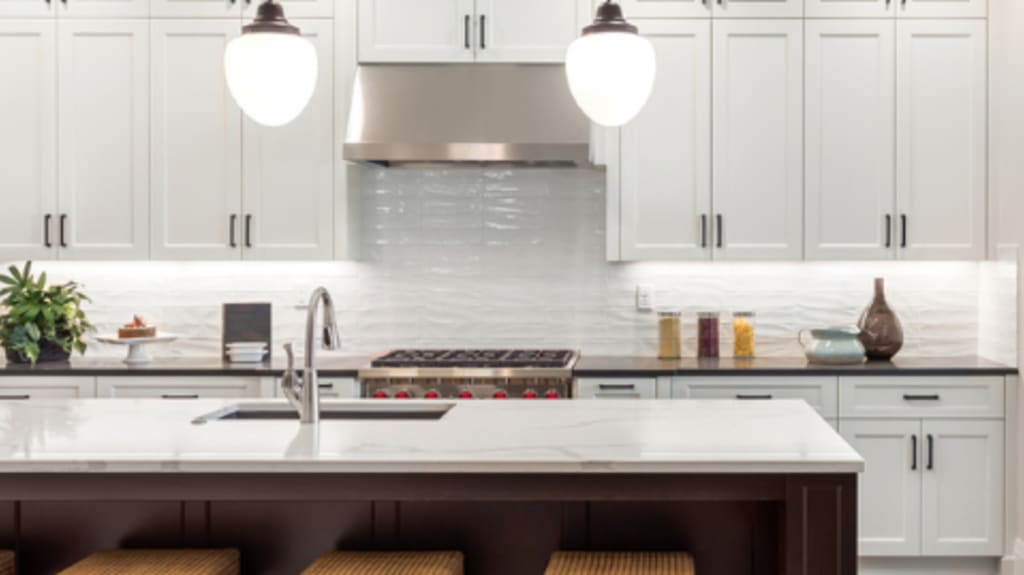Maybe you’ve been thinking about it for a while… You’ve scrolled through Pinterest, pored over design blogs, and looked at countless in-store samples. Or maybe you’ve just stumbled upon our kitchen renovation guide and started to consider it. Either way, it’s time to pick what type of flooring for your kitchen will be in your new home or give your current kitchen a much-needed facelift.
Natural or synthetic, affordable or luxury, there is an endless range of materials to choose from! Here are some things to consider when choosing the best flooring for your kitchen.
Important factors to consider when choosing your kitchen flooring
It’s essential to identify your needs before you start hunting for the perfect flooring for your kitchen. Loving a model’s aesthetic is not enough!
Price
The first thing you need to do is set your budget – it’ll be your starting point when you go shopping. Also, be sure to let the salesperson or advisor in store know so that they can direct you to models within your budget. If you find a flooring model you love, be sure to check out other manufacturers. Sometimes you can find a similar model at a cheaper price.
Style
Some flooring options only go well with specific styles, while others are more versatile. When shopping, it’s a good idea to have a few photos of the room on hand to see which flooring samples match your current style. You could also determine your ideal style. Is it more contemporary, rustic, boho, or chic?
Colour
Just like style, colour matters. The flooring colour must blend in well with other aspects of the room (e.g., furniture, accessories) for the layout to work.
Durability
To identify your needs in terms of durability, ask yourself whether the room is in a high-traffic area and if you have animals or small children that could damage the floor. In such cases, it’s a better idea to go with more solid flooring that will not get marked by claws or toys. It’s also an eco-friendly gesture to select flooring with a long lifespan.
Maintenance
When it comes to the kitchen, it’s best to select flooring that can be cleaned easily and is spill resistant. Tip: If you can’t stand seeing a stained kitchen floor, opt for a matte, light-coloured finish with many shades or visible veining – imperfections are less noticeable!
Installation
Who will install your flooring? You have many options to choose from if you’re hiring a professional. However, it’s better to select an easy-to-install model if a family member has been tasked with the job.
Material | Price | Durability | Humidity resistance | Cleaning | Installation | Eco-friendly rating |
Natural stone | $$$ | +++ | Easy | Difficult | ||
Porcelain tile | $$ | +++ | Easy | Difficult | ||
Cork tile | $ | ++ | Moderate | Easy | ||
Hardwood | $$$ | ++ | Moderate | Difficult | ||
Soft wood | $$ | ++ | Moderate | Difficult | ||
Concrete and epoxy | $$ | ++ | Easy | Easy |
| |
Vinyl | $ | + | Easy | Easy |
|
Note: The materials are listed in order of popularity. *For cork tile or wood flooring, check if the manufacturer has sustainability certifications.
Legend || $: $2–7 per square foot $$: $8–14 per square foot $$$: $15+ per square foot : low water resistance : moderate water resistance : high water resistance : good for the environment : very good for the environment : best for the environment
Types of kitchen flooring
Now that you’ve identified your needs, let’s dive into the specifics of each material so you can make an informed choice!
Wood flooring
Wood brings such a warm and cozy feel to a kitchen. In the past, homeowners were deterred from installing wood flooring in this room, but times have really changed!
Nowadays, this material is even more resistant to water and mould thanks to a layer of protective varnish with polyurethane. You no longer need to worry about damage from spills!
Hardwood: A classic

Hardwood is hands-down a favourite for all floors in the house. It also adds excellent resale value due to its noble character.
Pros: Hardwood is a timeless material that ages well. It instantly adds cachet to a room. In addition, consumers have endless choices because of the huge variety of wood species and stain colours available.
Cons: It’s less resistant to impacts and scratches than a ceramic or concrete surface. Fortunately, damaged hardwood flooring can be restored to its former glory with some sanding and painting.
Floating or laminate flooring: Great value

If you like the look of hardwood in the kitchen but it’s out of your price range, floating flooring is an excellent option.
Pros: Laminate flooring is quite easy to install (easier than hardwood) and comes in a variety of models that look great in any room of the house. It’s also a bit more durable than hardwood.
Cons: It’s made of less durable fibres and can contain harmful chemicals such as urea formaldehyde, which makes it less eco-friendly. It cannot be recycled and emits VOCs.
Bamboo: A subtle choice

With a look similar to hardwood, bamboo flooring is being used more and more in our homes. Its singular veining makes it easy to recognize. Bamboo is an eco-friendly choice as it grows so quickly. However, it loses points because it has to be imported.
Pros: It has a warm and inviting look. It’s harder than most wood species, which gives it superior resistance. It is also more resistant to insects.
Cons: Bamboo can be tricky to install; it’s better to hire a professional. Furthermore, despite its hardness, it dents easily after contact with heavy dropped objects.
Engineered wood

Many people can’t tell the difference between engineered flooring and hardwood flooring due to their similar appearance. The difference is that the first is manufactured with several superimposed layers, while the second comes from a single piece of wood.
Pros: It resists moisture better than hardwood and is ideal over heated floors. It can also be installed directly on a concrete floor, unlike hardwood or laminate.
Cons: It can only be sanded a maximum of three times, unlike hardwood which can be sanded many times over the course of its life. Plus, it is slightly less durable than hardwood, unless you pick a higher quality product.
Plywood: A bold choice

Plywood is usually used as subflooring; however, it can be ingenious exposed flooring when done right. For example, you can sand and stain plywood boards, cut them into tiles, and arrange them into a checkerboard pattern on the floor.
Pros: A fantastic look that costs a fraction of the price of other wood. You can pick the size and shape of tiles, which allows you to be more creative. Plywood is solid and has excellent stability.
Cons: The result isn’t chic enough for some people. It also doesn’t match many styles and accessories. Lastly, its resale value is tough to determine from a real estate standpoint.
Yellow birch: Reliable

Yellow birch is a very popular flooring choice because its close, straight grain pattern gives it a uniform look. It is also one of the hardest woods used for flooring.
Pros: It retains its colour for a long time, even after being exposed to direct sunlight day in and day out.
Cons: Despite its hard nature, it’s not as durable as concrete or porcelain.
Cork: Eco-friendly

Cork is made from tree bark that has reformed after cutting, so no felling required! In addition, it absorbs more CO2 than most trees. This makes cork an eco-friendly choice.
Pros: It’s more comfortable than wood due to its density and texture, and it’s slip resistant. It can also help reduce noise transfer from one floor to the next! Cork is resistant to temperature changes and will not develop mould if properly treated. It is affordable and easy to install.
Cons: Cork flooring needs to be recoated with a sealing treatment every 3 to 4 years to prevent moisture damage. It’s also quite fragile and gets scratched easily. This means its surface can be marred by imperfections over the years, which can be rather frustrating.
Natural stone
Natural stone always stands out in the kitchen: its raw and timeless look steals the show! To prevent your space from looking too busy, it’s best to pair it with simple accessories. Natural stone is eco-friendly (especially when buying local) and is easy to clean.
However, its hard nature is not the most comfortable! Some homeowners dislike how cold it is on the feet in wintertime, but a heated floor system could solve that issue. It’s also worth noting that natural stone is one of the most expensive flooring options out there.
Granite: Colourful

Very hard and not very porous, granite is available in different shades, from green and grey to black and pink. It usually has a very textured look. You can also choose from various finishes: flamed, striped, polished, bush hammered, sawn, or honed.
Pros: As with all stone, it is durable and creates a chic and warm look. With so many colour combinations to choose from, it’s easy to find something that matches the rest of your decor.
Cons: It looks a little dated. However, its noble nature means it’s never totally out of fashion.
Marble: Luxurious

Marble is easy to recognize due to its veining. Current trends are focusing on marble with a mix of creamy white and grey veins, but it’s still possible to find it in shades of beige, pink, green, and black. Although most homeowners opt for a polished and glossy finish, you can also get it in matte.
Pros: Marble will resist stains and wear out less quickly after being protected with a good sealing treatment. It’s a top trend right now.
Cons: It is very heavy. It is a good idea to confirm the room can support its weight if there is a large surface area to cover.
Limestone: Rustic

Limestone flooring is usually grey or beige and has a matte texture.
Pros: It can be left unfinished or be polished to feel softer underfoot. Since this type of material is commonly sourced in Quebec, choosing it means that you’re supporting local businesses!
Cons: This stone stains easily if it comes into contact with grease because it’s very porous. However, it can be protected with a sealing treatment.
Slate: Refined

Its natural look is sought after by homeowners, mainly in shades of black and grey. While some models are easy to install (like ceramic), others require a mortar bed, which can complicate the task at hand.
Pros: Its colour doesn’t fade in the sun, and it has a long lifespan.
Cons: This natural stone is slightly less durable than its counterparts, no doubt due to its irregular surface, making it more susceptible to cracks. It can also erode over time.
Other trendy kitchen flooring options
Natural materials like wood and stone add charm while connecting you with nature. There are lots of other materials to consider, too!
Epoxy: Creative

Whether you want to coat a garage floor or liven up the kitchen or bathroom, epoxy is a versatile flooring option. You can select a glossy or matte finish and neutral (black, white, grey) or vibrant colours (pink, yellow, green, blue).
Pros: Epoxy is the way to go if you’re looking for a relatively foolproof surface. Despite impacts and liquid or grease spills, it will come out unscathed because of its waterproof nature after being sealed. This type of flooring also requires minimal maintenance.
Cons: It doesn’t work with all styles – it has a certain je-ne-sais-quoi to it that feels out of place in a classic or rustic setting. Its hardness can also make it uncomfortable to walk on for long periods of time.
Ceramic: Versatile

Ceramic comes in a variety of sizes, textures, and colours, allowing it to blend harmoniously into all styles. Some ceramics even mimic the appearance of wood or concrete!
This flooring is undeniably the most popular option in kitchens, both commercial and residential. And given its benefits, it’s not surprising at all!
Pros: This flooring is easy to clean, which is a must-have in such a busy room! Whether it’s matte or glossy, ceramic is also moisture and scratch resistant and doesn’t dent. In short, it has an impressive lifespan! And if one tile breaks, it can be easily replaced.
Cons: The sealant can fade and stain over the years, which diminishes its appearance. However, you can add a grout protector. If you spend a lot of time in the kitchen, its hardness can impact your joints just like concrete or epoxy flooring. Another negative point for many people: ceramic is always cool underfoot unless you install a heated floor system.
Porcelain: Resilient

Porcelain has all the same pros and cons as ceramic – they even look the same and have similar price ranges. The differences lie in how they are made. However, porcelain is more durable than ceramic.
Concrete: Modern

It’s rare for homeowners to choose a concrete kitchen floor. It can offer a gorgeous look that’s perfect for both contemporary and industrial styles. While it’s mostly seen in lofts, it could look great in a single-family home. So if you like its appearance, go for it!
Concrete looks good in its raw state, but it can be enhanced with some paint, stain, polish, or wax.
Pros: This is one of the most durable flooring options around! It’s resistant to cold, heat, and impact, and, as an added bonus, it’s easy to maintain, especially if it has a glossy finish.
Cons: It can erode rapidly if it comes into contact with chemicals (stains can often appear). It’s a good idea to seal it regularly to ensure its longevity. Unfortunately, in addition to being chilly, it’s not the best surface for joints because of its hard nature.
Vinyl: Affordable

Vinyl comes in many trendy styles and is nothing like what you remember from the 80s. It’s become sophisticated and can even look like wood or concrete.
Pros: It’s cheap, easy to maintain, and durable (you can slide furniture on it without worrying about scuffing). It can withstand impacts and has good water resistance. Its slightly cushioned texture is gentle on joints unlike hard surfaces like wood, concrete, or stone.
Cons: This material attracts dust and dirt which means bare feet can get dirty easily. Vinyl also wears out faster than a raw material like wood. Another downside: it’s one of the least eco-friendly flooring options because it has a short lifespan, is difficult to recycle, and is made from potentially toxic elements.
Linoleum: Convenient

Made from a jute backing that’s been waterproofed with linseed oil and wood flour, linoleum is an eco-friendly choice when it’s PVC-free. It’s as practical as vinyl while being more environmentally friendly.
Pros: It is impact and mould resistant and will not get scuffed if someone drops a heavy object. It is cheap, hypoallergenic, and cleans like a charm if you’ve applied a protective covering. It also has soundproofing properties.
Cons: Linoleum can be rather difficult to install. Moisture will quickly get in if its protective covering has faded.
Frequently asked questions: Everything about kitchen flooring
Which kitchen flooring option is the least expensive?
Vinyl is the most affordable option, but some types of floating wood and ceramic go on sale at a cheap price. Keep an eye out for deals!
What types of kitchen flooring are easy to clean?
Ceramic and porcelain can be cleaned in a jiffy due to their non-porous nature. Natural stone or concrete come in second.
What are the most eco-friendly kitchen flooring materials?
Hardwood flooring made from local and sustainably harvested wood is a great choice. Local natural stone is another good option. You can also consider linoleum made from recycled materials or cork and bamboo, as those trees grow fast.
Kitchen flooring: What is trending?
Large (24 x 24 in) ceramic and porcelain floors are in, along with concrete and marble. Cork is also growing in popularity due to its natural and zen-like appearance.
What flooring is easiest to install?
Laminate, vinyl (mainly in rolls), and cork flooring are usually the easiest types to install.
How to choose a flooring colour?
The colour of your floor will have an impact on the style of your room. It should match the other colours and design elements in your kitchen. For example, red epoxy flooring will stand out in a classic kitchen, just like mixing different types of wood in the same room (counters, backsplash, cupboards, floor).
Can you paint kitchen flooring?
That depends on the type of flooring you choose. A concrete, ceramic, or porcelain floor can be painted. However, you must pick the right paint for each. You can paint wood flooring, but you may not like the end result.
What is the most durable kitchen flooring?
Ceramic, porcelain, epoxy, concrete, limestone, marble, and granite.
Conclusion
In addition to considering the pros and cons of each flooring type, it’s important to choose flooring based on your own tastes and that matches the existing layout. In fact, if you want to get inspired by current trends, take a look at our article on dream kitchen designs.
By Julie Loiselle
For as long as she can remember, Julie has been expressing herself through writing. Her ease with words has landed her various contracts in marketing and advertising, as well as for magazines and blogs. Like a chameleon, she adapts her tone and style for each new project. Her favourite subjects? Interior and exterior design.




